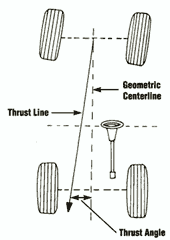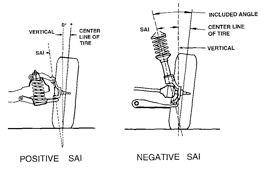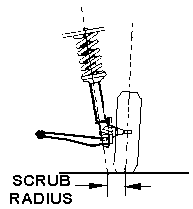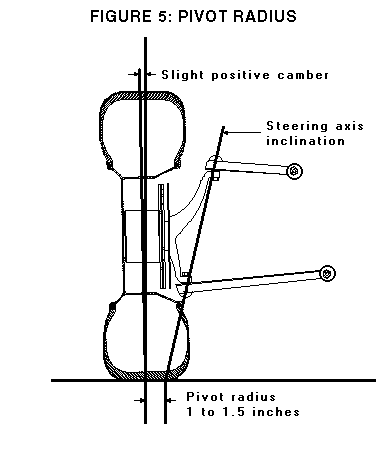This thread is to talk about the alignment terms and measurements and how they relate to TJs and other vehicles in general. I'll try to explain why and how our Jeeps act how they do to the best of my ability. I've been doing 10-12 alignments a day on everything from Civics and Malibus to TJs and Cherokees to Corvettes and high dollar Mercedes for the last few months straight so I'd like to think I'm fairly qualified to do this write-up.
Let's start with the basics: Camber, caster, and toe.
![Image]()
Camber - Camber is the angle that the tires are at from top to bottom when looking at it from the front. It is generally slightly negative (top of tires tilted inwards). I don't know of any vehicles that have the actual spec in the positive (top of tires tilted outwards), but some allow enough tolerance to allow a small amount of positive camber though it's not recommended.
Whatever side has more positive camber is the side that will want to generate a pull. This is because whatever is closer to 0 will have more of the tire touching the ground causing more rolling resistance on that side.
Example: -0.30 camber on left and +0.10 camber on right, should pull to the right
One question I've been asked was what about -0.30 on the left and +0.30 on the right, shouldn't it drive straight because equal amounts of the tire are touching the ground? Common sense would initially say yes, but since the right side's contact patch is further away from the ball joints in relation to the left(steering knuckle pivot), there is more leverage on the right side making it easier for the smallest imperfections in the road to make it want to turn that way.
Also know that camber is NOT adjustable on TJs without special offset ball joints. Chances are though that if you need those ball joints, you very well could have a bent axle housing. Ensure it is straight before buying expensive ball joints!
![Image]()
Caster - As far as caster goes, it can give the feeling of pulling. When you turn your wheels left and right, they do not rotate on a 100% vertical axis. This primarily affects your "return to center" effect. The upper ball joint should be further back than the lower ball joint resulting in a 4-8 degree tilted axis that the wheels rotate on (viewed from the side). Under no circumstances am I aware of should you have negative caster (tilted forward). You should have positive caster. The more caster you have (say 8 degrees); the more quickly the steering wheel will return to center when coming out of a turn. With less caster (say 4 degrees) it will not return to center as quickly. Also note that caster will very slightly affect how "hard" it is to turn, as with less caster you aren't fighting as much of that return to center tendency that the vehicle has. Really low overall caster will cause a "wandering" feeling and will more likely pull whatever way it wants with the smallest road imperfections/dips.
If you have driven a BMW/Mercedes/Audi/etc, you've probably noticed how "stiff" the steering feels, this is mainly because they have a lot of caster (some between 9-10 degrees!) built in for more high speed Autobahn stability.
Generally when I do alignments, I will set the caster on the right side to whatever the left side is, +0.3 to +0.5 degrees.
Example: +6.5 on left side and +6.8 to +7.0 on right side
What this does is account for road crown.
Road crown is the term for how most public roads are tilted towards the right side for water to run off and keep it from pooling where you're driving. Without caster being set a bit higher on the right side, in the right lane on the road the vehicle tends to wander to the right.
Either way it's non adjustable on Jeeps, all you can adjust (with adjustable upper control arms or cam-bolts) is the overall caster. Both steering knuckles are attached to each other with the solid axle, you tilt one backwards, you tilt the other backwards. Not adjustable in relation to each other. You could cut the weld on a knuckle and rotate it, but that's rarely needed.
![Image]()
Toe - Let me start by saying TOE DOES NOT CAUSE A VEHICLE TO PULL! You just set the toe to spec and then center the steering wheel with the drag link(the drag link does not affect the alignment of the tires, only centers the steering wheel). On a solid front axle vehicle (like TJs), you can only set the TOTAL toe, since both steering knuckles are connected. It's impossible to adjust individual toe as there is not a separate tie rod on each side of the steering gear.
Since toe is the only adjustment you can make in stock form on a TJ, it is not really necessary to get an alignment just to set toe. Save $80 by doing it at home with a tape measure and some basic hand tools. You'll need to adjust toe and/or recenter your steering wheel any time you replace any of the tierod ends, there is a great write-up on this at www.4x4xplor.com which is worth taking a look at. There is also a good diagram of the steering components and their terms as well.
Now that you've had a basic crash course in alignments, let's get onto some more good stuff!
Edit 1/5/09: Added link to driveway alignment for setting the toe.
Let's start with the basics: Camber, caster, and toe.

Camber - Camber is the angle that the tires are at from top to bottom when looking at it from the front. It is generally slightly negative (top of tires tilted inwards). I don't know of any vehicles that have the actual spec in the positive (top of tires tilted outwards), but some allow enough tolerance to allow a small amount of positive camber though it's not recommended.
Whatever side has more positive camber is the side that will want to generate a pull. This is because whatever is closer to 0 will have more of the tire touching the ground causing more rolling resistance on that side.
Example: -0.30 camber on left and +0.10 camber on right, should pull to the right
One question I've been asked was what about -0.30 on the left and +0.30 on the right, shouldn't it drive straight because equal amounts of the tire are touching the ground? Common sense would initially say yes, but since the right side's contact patch is further away from the ball joints in relation to the left(steering knuckle pivot), there is more leverage on the right side making it easier for the smallest imperfections in the road to make it want to turn that way.
Also know that camber is NOT adjustable on TJs without special offset ball joints. Chances are though that if you need those ball joints, you very well could have a bent axle housing. Ensure it is straight before buying expensive ball joints!
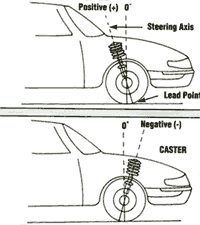
Caster - As far as caster goes, it can give the feeling of pulling. When you turn your wheels left and right, they do not rotate on a 100% vertical axis. This primarily affects your "return to center" effect. The upper ball joint should be further back than the lower ball joint resulting in a 4-8 degree tilted axis that the wheels rotate on (viewed from the side). Under no circumstances am I aware of should you have negative caster (tilted forward). You should have positive caster. The more caster you have (say 8 degrees); the more quickly the steering wheel will return to center when coming out of a turn. With less caster (say 4 degrees) it will not return to center as quickly. Also note that caster will very slightly affect how "hard" it is to turn, as with less caster you aren't fighting as much of that return to center tendency that the vehicle has. Really low overall caster will cause a "wandering" feeling and will more likely pull whatever way it wants with the smallest road imperfections/dips.
If you have driven a BMW/Mercedes/Audi/etc, you've probably noticed how "stiff" the steering feels, this is mainly because they have a lot of caster (some between 9-10 degrees!) built in for more high speed Autobahn stability.
Generally when I do alignments, I will set the caster on the right side to whatever the left side is, +0.3 to +0.5 degrees.
Example: +6.5 on left side and +6.8 to +7.0 on right side
What this does is account for road crown.
Road crown is the term for how most public roads are tilted towards the right side for water to run off and keep it from pooling where you're driving. Without caster being set a bit higher on the right side, in the right lane on the road the vehicle tends to wander to the right.
Either way it's non adjustable on Jeeps, all you can adjust (with adjustable upper control arms or cam-bolts) is the overall caster. Both steering knuckles are attached to each other with the solid axle, you tilt one backwards, you tilt the other backwards. Not adjustable in relation to each other. You could cut the weld on a knuckle and rotate it, but that's rarely needed.
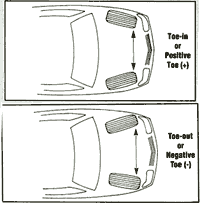
Toe - Let me start by saying TOE DOES NOT CAUSE A VEHICLE TO PULL! You just set the toe to spec and then center the steering wheel with the drag link(the drag link does not affect the alignment of the tires, only centers the steering wheel). On a solid front axle vehicle (like TJs), you can only set the TOTAL toe, since both steering knuckles are connected. It's impossible to adjust individual toe as there is not a separate tie rod on each side of the steering gear.
Since toe is the only adjustment you can make in stock form on a TJ, it is not really necessary to get an alignment just to set toe. Save $80 by doing it at home with a tape measure and some basic hand tools. You'll need to adjust toe and/or recenter your steering wheel any time you replace any of the tierod ends, there is a great write-up on this at www.4x4xplor.com which is worth taking a look at. There is also a good diagram of the steering components and their terms as well.
Now that you've had a basic crash course in alignments, let's get onto some more good stuff!
Edit 1/5/09: Added link to driveway alignment for setting the toe.


